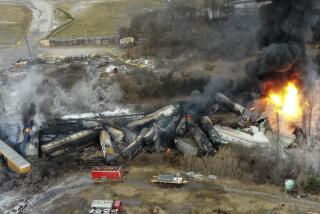Inspector Found No Faults With Crane
- Share via
The inspector who certified the crane involved in the worst shipyard accident ever at the National Steel & Shipbuilding Co. said he found “no problems” with the crane when he inspected it in March.
Charles Remoll, who works for the New York-based International Cargo Gear Bureau Inc., said he certified the crane after a routine inspection March 5. Remoll, a retired Navy officer, taught engineering at the U.S. Naval Academy.
“I saw no problems with the equipment. Nassco has an outstanding maintenance and safety program for operating its cranes,” said Remoll, who has inspected Nassco’s cranes since 1978.
The ICGB is an independent company that contracts with various manufacturing firms throughout the
United States when their cranes need to be certified for operation. In California, the state requires all cranes to be certified. Typically, Nassco contracts with the ICGB to inspect the cranes.
According to Remoll, federal and state safety regulations require all cranes to be inspected annually, followed by a more thorough inspection every four years that requires overload testing 10% to 25% above the listed safe working limit. The more thorough inspections are also required when a crane is overhauled or critical parts replaced, he said.
Crashed on Deck
A team of investigators and technical experts is currently looking into the July 10 accident that killed 6 workers and injured 6 others to determine whether it was caused by operator or mechanical error. Witnesses said a steel personnel basket carrying the 12 men came crashing down on a ship’s deck when the cable apparently failed to brake.
Remoll declined to comment on the crane involved in the accident or the operator, but he said other cranes like the Nassco crane that is being studied have primary and secondary braking systems.
“The backup braking system makes it highly unlikely for both systems to break down at the same time,” Remoll said. “The probability of complete breakdown (primary and secondary) is small. The primary electric system is electrically powered, while the secondary system is powered by either hydraulic or pneumatic pressure.”
The secondary braking system is a mechanical brake that is applied much like a car’s parking brake. As explained by Remoll, most operators are trained to routinely apply the mechanical brake when they stop a load in midair before turning the boom.
Cranes like the one involved in the accident are also designed to brake in the event of a power failure, Remoll said.
A union official at Nassco who did not want to be identified said the cable, which can be from 7/8 to 1 inches thick, apparently did not brake and continued to “freewheel” down toward the deck of the ship. The freewheeling cable was described as being similar to a fishing line that continues to pull out from a fishing reel when the reel’s brake fails to lock the line.
Powered by Diesel
The crane involved in the tragedy runs on fixed tracks and is commonly called a gantry. It is powered by a diesel engine that generates electricity to power the boom. Conventional hydraulic cranes operate on the ground and can be moved from one location to another.
Hugh Humphrey, the crane operator at the time of the accident, had more extensive experience operating conventional hydraulic cranes.
Fred Hallett, Nassco vice president and spokesman, and Don Kidd, an official with the Operating Engineers International Union, Local 12, which represents Humphrey, said that he was trained and qualified to operate a gantry.
Though hydraulic cranes and gantrys may be basically similar, Remoll said there are significant “operational differences” in the two machines.
“From my point of view, it’s like driving different types of vehicles,” Remoll said. “Driving a car with power steering, power brakes and an automatic shift is far different from driving a truck without power steering, power brakes and with a gear shift on the floor. You just don’t graduate from operating one (crane) to the other.
“A substantial amount of retraining is required when you go from a hydraulic crane to a gantry. But Nassco knows this, and it is one of the most safety-conscious shipyards I’ve ever been in. I’m impressed with the company’s people, from the ground up.”
More to Read
Sign up for Essential California
The most important California stories and recommendations in your inbox every morning.
You may occasionally receive promotional content from the Los Angeles Times.










